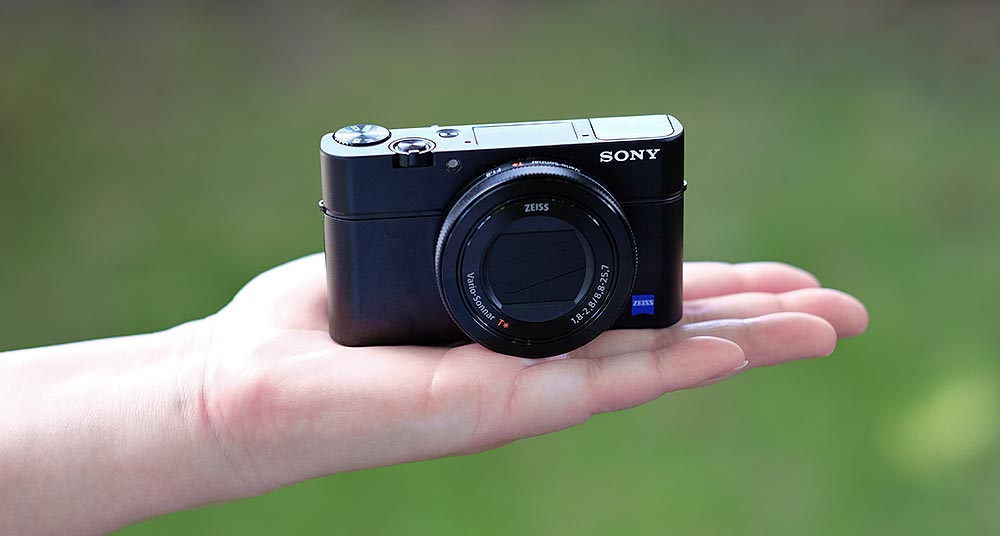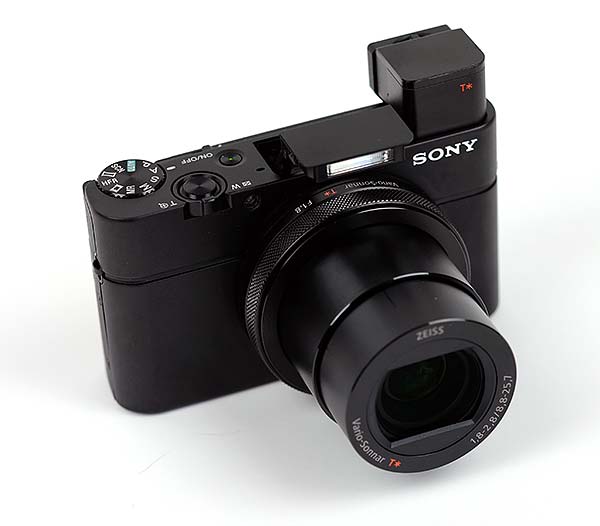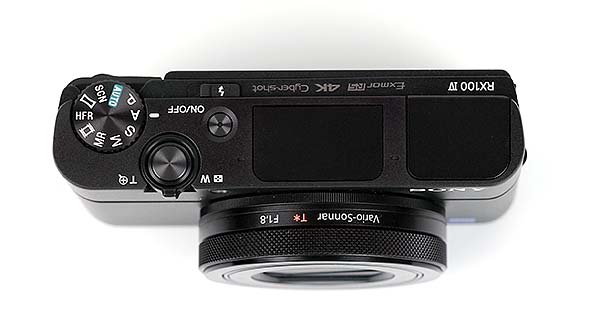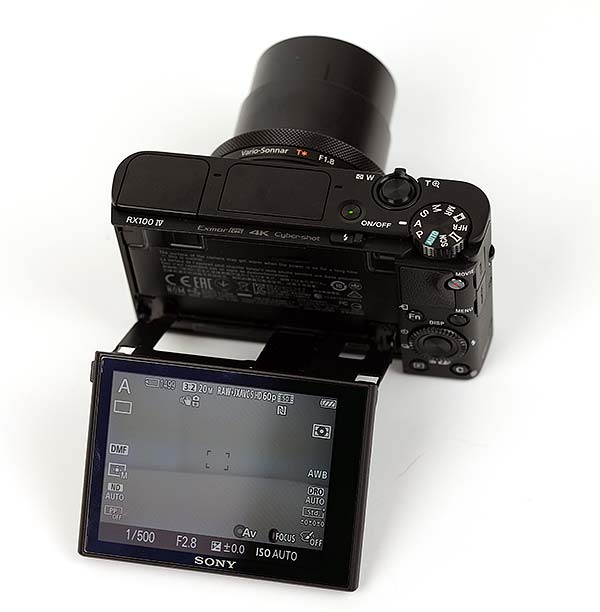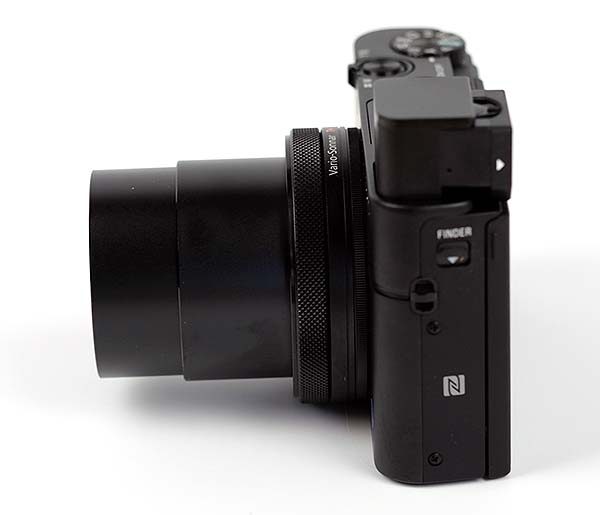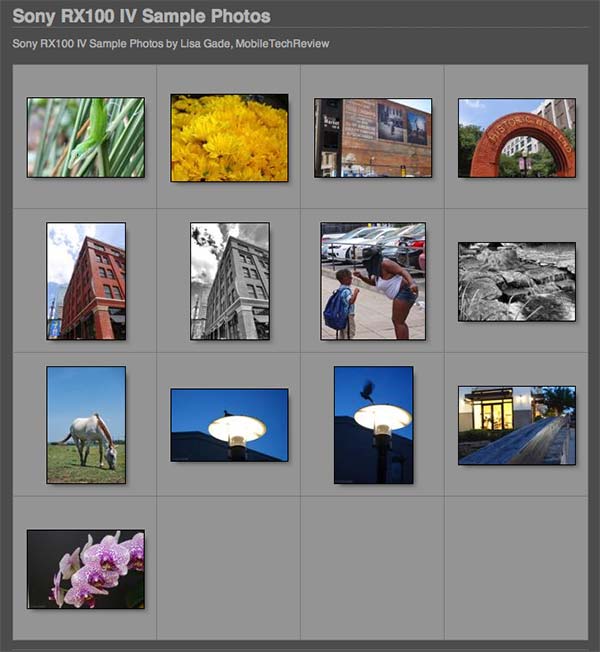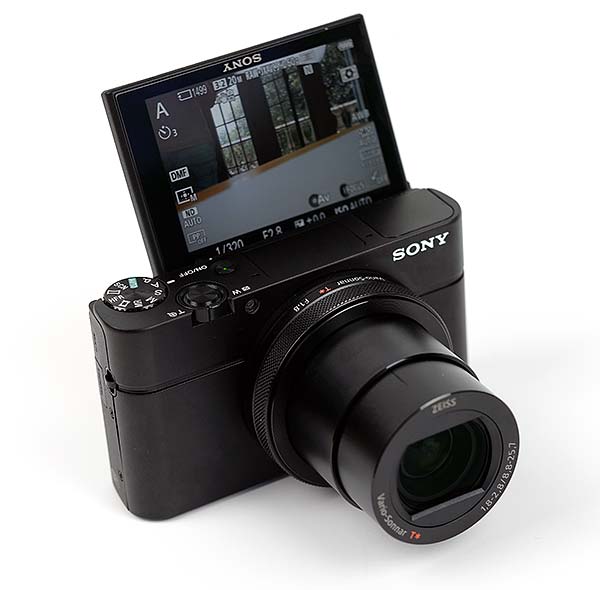
|
|
|||||||
|
Home > Gadget Reviews > Sony DSC-RX100M4
Sony RX100 IV
What's Hot: Impressive image and video quality for a camera this small, offers manual controls and RAW. Does high bitrate video recording, 4K and slow motion. What's Not: Very expensive, can only record 4K for 5 minutes at a go, slow motion video quality not high.
Reviewed July 28, 2015 by Lisa Gade, Editor in Chief (twitter: @lisagade)
|
|||||
|
The Sony RX100 mark 4 hardly needs an introduction, after all it's the fourth generation in one of the most successful lines of popular high end pocket cameras. It still rates at 20.1MP, but the Exmor RS 1" stacked sensor design is radically new, and that sensor brings new features including 4K video recording, potentially better image quality and extreme slow motion video recording. To look at the mark 4, you'd think it was the mark 3 since the body hasn't changed. Indeed, you still get a tiny pop-up EVF (same size, but upgraded to XGA resolution), 3" rear flippable LCD and 24-70mm f/1.8-2.8 equivalent zoom lens. But inside, it's an even more high tech animal. The Sony weighs 10.5 ounces with battery and SD card, and it's as small as any of the more compact point and shoots. Unlike point and shoot cameras with even smaller sensors, the RX100 captures surprisingly high quality images and video--it's truly a marvel of technology given its size. And you'll pay dearly for that since it sells for $950, which is nearly as much as the Sony RX10 II or the first generation Sony a7 full frame ILC (body only). It has a 3x zoom lens not unlike kit zoom lenses, and those upgrading from a point and shoot might find it a bit lacking in telephoto range since cheaper pocket cameras often have longer zooms. Why the shorter zoom on such and expensive camera? Sony focused on optical quality instead with the Zeiss Sonnar T* lens. It's a remarkably sharp lens with lovely contrast and colors. Granted there's distortion, particularly at the wide end that you can see in the EVF since it shows you what the sensor sees rather than a corrected JPEG, but the camera's JPEG processing cures the barrel distortion, as does the included Capture One Express desktop software for RAW conversions.
Design and Ergonomics We won't dwell long on the RX100's design because frankly it's barely changed over the generations. Rather than going with the retro look that's so popular with high-end mirrorless cameras these days, the RX100 is fairly modern and sleek. It's also tiny and slippery. The black metal casing has no textured coating or faux leather, and the closest thing you'll get to a grip is a hint of a rubbery thumb rest mounted on the upper right rear. The body is all metal, befitting a camera this expensive, and it feels convincingly rigid, though it's by no means meant for rough handling or splashes from the rapids as are professional dSLRs. The rear flipping LCD goes up and down but not sideways, and the hinge mechanism, like the tiny pop-up flash's may feel delicate but they hold up well with a year of use, based on our testing of past generations. The LCD can flip up for selfies, down for over the head concert shots and up so you don't have to kneel on the ground to grab that butterfly or crawling baby shot. Controls and Ports Controls are simple and small; Sony has little room to work with on this 4 x 2 3/8 x 1 5/8 inch camera. There's a single metal control dial up top with the standard PASM modes, auto mode, video and the new HFR (high frame rate recording) mode. Zoom is controlled by the single ring surrounding the lens (updated with a crosshatch pattern for better grip) or via the lever in front of the shutter button. That lens ring changes based on context--in aperture priority mode it changes aperture, in shutter priority mode it changes the shutter speed. It can also be assigned to DMF (direct manual focus, aka tweaking focus after auto-focusing). The rear Fn button brings up quick settings, typical of Sony cameras, and there's a small d-pad with control wheel on the rear. There are two ports: micro USB for charging, image transfer and firmware updates and a micro HDMI out port for monitoring recording and playback to a TV. Despite some high end to pro videography features, there's no mic jack, headphone jack or hot shoe to use an external mic. Your only options are the built-in stereo mic that's good enough for recreational use or an external recorder and that you'll sync to your recorded video in Premiere, Vegas, Final Cut or the video editor of your choice.
Image Quality The new stacked sensor in theory allows for better image quality, or at least less noise through reduced signal loss. The RX100 II and RX100 III already have very low noise levels given the 1" sensor, so we're starting from such a high baseline that's it's hard to say that noise levels are noticeably reduced. Low light, high ISO shots are where you'll find the most noise in digital cameras, and that's already well controlled thanks to the effective BSI (backside illuminated sensor) used since the mark II. Since the Sony has a relatively larger sensor for a point and shoot (and much larger than smartphone cameras), but a tiny sensor compared to dSLRs and ILCs with APS-C and 35mm full frame sensors, noise falls in between, but is closer to the bigger sensor camp. Noise is certainly there in nighttime shots, but it's well managed. In fact, the RX100 IV's photos might fool you into thinking they were taken with a Micro Four Thirds or APS-C camera. Colors are rich and true, dynamic range is amazingly good for a camera and sensor of this size and images are extremely sharp. No, dynamic range doesn't match the larger sensor cameras, but it doesn't fall horribly short and you can bring out a good deal of shadow detail in RAW files. The RX100 continues to be a marvelous combination of miniaturization, image quality and available manual controls.
Trivia: all photos of the RX100 IV in this review were taken with the Fujifilm X-T10. That's grand, so where does it fall behind bigger cameras with larger sensors? Depth of field control is sorely lacking, and that's simply a fact of life with a 1" sensor. A fast lens is only part of the required formula if you want strong subject isolation with background blur and pleasing bokeh--sensor size plays an equally important part. If you're a portrait photographer, artsy shooter or an object photographer, the RX100's lack of shallow depth of field may put a cramp in your photographic style. If you mostly shoot landscapes, vacation shots or sports where you want most everything in sharp focus with little background blur (if any), then this is a camera that could work for you. If you want something that's larger but still pocketable (assuming roomy pockets), then consider the Panasonic Lumix LX100. It has a Micro Four Thirds sensor (albeit lower resolution), and it allows for some pleasingly shallow depth of field and has a similar zoom range with a lower price tag. The new sensor means faster burst shooting, and Sony claims 16.7 fps burst shooting in JPEG (lower in RAW), which is quite fast for a tiny camera. The catch is that you must use electronic rather than mechanical shutter for these fast speeds. The electronic shutter max speed is an insane 32,000th of a second. You'll also need to use Sony's speed mode that has limitations. |
Deals and Shopping:
Advertisement |
||||
|
Sony RX100 IV Video Review
Slow Motion! Here's a party trick that will get old quickly unless you're one of those folks who actually has a persistent need to slow things down. Certainly extreme slow motion can be useful for sports training, for example. Beyond that, it's fun to slow down water splashes, your dog's leap into the air to catch a Frisbee and slow motion slam-dunks. Not that you'll be doing that all the time... Sony offers 3 HFR (high frame rate) modes: 240 fps, 480 fps and 960 fps. How slow that is depends on whether your baseline video recording is set to 24p, 30p or 60p. The lower the baseline, the slower the effect will be, so at 60p you can slow things down 16x (which indeed looks very, very slow) and 40x at 24p (insanely slow). We have a sample video below that shows how the 3 HFR modes look at a baseline of 60p.
OK, you've watched that video directly above? Notice that the 960 fps video is low quality, in fact it's around 360p resolution. Sony up-samples HFR video to 1920 x 1080, but it's actually recorded at lower resolutions. 480 fps is approximately HD (508p) and 240 fps is almost full HD. Since few consumer cameras can approach such high frame rates, we won't dwell on this, but caveat emptor--it won't be the sharpest of footage. It is still pretty darned cool. Even better, the camera has a 120 fps setting that isn't part of the HFR package--you simply choose it in the main menu under video settings. That stuff is very sharp and is full HP 1080p. Granted some smartphones can do 120 fps too, but the RX100 IV's quality is much better. Other things to note with HFR: you'll choose either pre or post capture from the moment you hit the record button, and it will record for approximately 2 seconds at 960 fps. That means you have to choose your moment very carefully--pre-planning works best. That 2 seconds turns into 80 seconds of video. Video Recording 4K is one of the RX100 IV's top new features, made possible by the new more efficient stacked sensor. That stacked sensor also allows for full sensor readout, which should reduce rolling shutter and that annoying jello effect when panning the camera (buildings and other verticals bending when you move the camera horizontally). It certainly helps, though there's still a little jello. There's a 5 minute 4K recording limit, because heat is still the bane of small Sony cameras. The sensor gets mighty hot, and this sort of limit is also standard on smartphones that can record 4K video. When recording 1080p there is no such limit, though we did see the usual heat warnings around 8 to 15 minutes into recording. You can turn the camera off for a few minutes when you see this, or live dangerously and wait until it shuts itself off (we prefer not to live dangerously). 1080p video quality is very good, and you can now record at higher bitrates with better codecs--right up to 100Mbps XAVC-S, which is downright astounding for a tiny camera. The old AVCHD and MPEG4 are available too for those who use older video editors or slower machines to process video. Quality is indeed better at 4K, with more detail and perceived sharpness when viewing on a less than 4K display or down-converting to 1080p. Note that Sony requires a 64 gig SDXC class 10 UHS-1 card for XAVC-S recording and the harder to find and more expensive UHS-3 for 100M bitrate recording. What they have against 32 gig cards, we don't know, but the camera will say "nope" if you try to use one for these high quality formats even if it meets the required standards and speed rating.
As noted, there's no hot shoe, mic port or headphone port, which limits this otherwise high end video camera for serious to professional use. The stereo built-in mic is fine for recreational use, but those who require high quality audio will have to use an external recorder like the Zoom and sync audio to video in post. Or you could just buy the Sony RX10 or RX10 II, if you don't mind the larger, heavier body. It would be our pick over the RX100 IV for video since it doesn't have such pronounced heat limitations and it has a hot shoe for wireless and standard hot shoe mics. The RX100 is in many ways the pocket version of the RX10, minus the super zoom lens. Sample Image Gallery Click on a photo to see a larger image. |
Advertisement |
Battery Life Mirrorless cameras don't have the best battery life, in part due to the power hungry EVF and LCD, but also because manufacturers try to make the cameras as small as possible so there's less room for a beefy battery. Sony slightly downgraded the shot estimates for the mark 4, so you're looking at 280 photos per full charge. Video will eat the battery much more quickly. We suggest you buy a spare battery and an external charger. Sony includes a USB cable for image transfer and charging, but no standalone charger. Conclusion The Sony RX100 IV, like its predecessors, is a marvel of miniaturization. This is quite a powerful camera for its size and it takes photos and videos that look noticeably better than point and shoots. Of course, that comes at a price, and this is a $950 camera. Those on a budget would do well with the RX100 II (my personal favorite since you get the BSI and a hot shoe) or the RX100 III. And those who are accustomed to doing more advanced photography and desire greater control over depth of field and want a more "filmy" look should consider the very good Panasonic Lumix LX100--it's a few hundred dollars cheaper, has a larger sensor and can shoot 4K video too, though not at Sony's high bitrates. If you have an RX100 original model, I'd consider the upgrade, but if you already have the II or III, I'd hesitate to spend the money just to get a still undersized but higher resolution EVF, 5 minute 4K recording and slow motion. Price: $949 Website: www.sony.com Camera Reviews and Articles: 5 Photography Tips to Improve Your dSLR and Phone Photos dSLR vs. Mirrorless Cameras: What's the Difference and Which Should You Buy?
|
|
|
